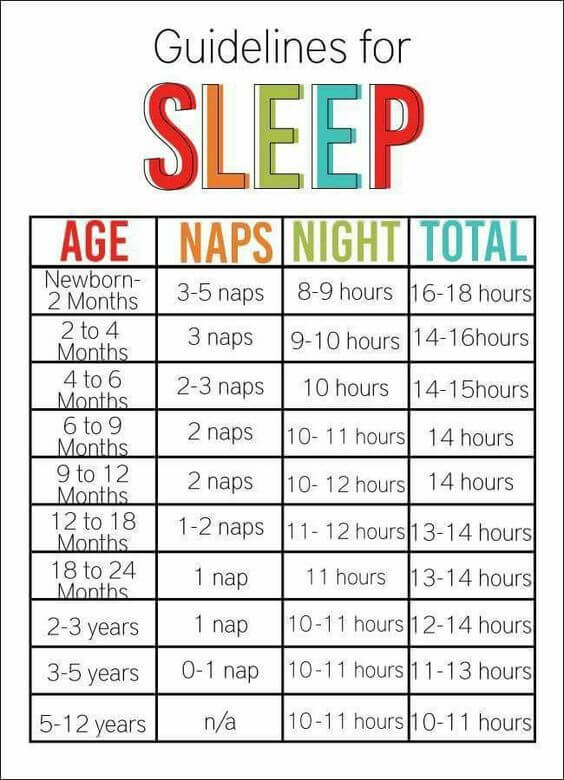Infant Sleep Chart: How Much Should a Baby or Child Sleep?

With the arrival of a child, sleep is one of the aspects that most worries parents. Frequent awakenings, difficulties falling asleep, doubts about whether they’re getting enough rest… all these issues can cause doubts in parents. For this reason, we want to share with you the infant sleep chart so that you can consult it as your little one grows.
Indeed, rest is essential for the proper development of little ones and this is due to various factors. On the one hand, during sleep, there’s a maximum release of growth hormone. In addition, some metabolic regulation processes are carried out, which prevent excess weight and contribute to replenishing the energy spent during wakefulness.
On the other hand, while little ones sleep, their brains create and strengthen neural connections. Therefore, they consolidate certain information while discarding other information. In short, they optimize their functioning and cognitive abilities.
Therefore, sleep deprivation can affect infant growth, health, and daytime performance. Now, how do you know if your baby or child is getting all the sleep they need? We’ll tell you.
The infant sleep chart
This practical tool allows you to easily see how many hours of sleep your child needs. It indicates the hours of rest required at each stage of life, but it does so as a guide. We can’t forget that each child is different, has specific needs, and progresses at their own pace.
Even so, it’s very convenient to know the average rest times for each age and the recommendations that experts offer in this regard. This will allow you to detect if your child has an insufficient sleep routine or if, on the contrary, you’re worrying unnecessarily about this aspect.
You should know that forcing your child to rest more than required can also be counterproductive. For example, encouraging a child to take longer naps than necessary, or to take them when they’re no longer needed can impair their night’s rest and make it difficult for them to fall asleep.
For all of these reasons, we recommend that you keep this table at hand and consult it whenever you need it.

How much should a baby sleep?
Sleep in babies is very different from sleep in adults. Im the beginning, baby’s only present two phases of sleep (compared to the 5 that they’ll develop later). In addition, they have frequent awakenings in order to be able to receive food, attention, or comfort, and it’s difficult for them to differentiate between day and night. Therefore, they tend to sleep a large number of hours spread evenly throughout the day.
As they grow and mature, the total hours of sleep decrease and the pattern begins to shift towards nighttime sleep. In this way, they’re able to sleep more and more hours in a row at night and need fewer naps. In any case, this can be a difficult process for parents, as it affects their own rest. However, having the necessary information can greatly help to overcome difficulties.
During the first months of life, a baby will need between 16 and 18 hours of sleep in total. However, already at three months, it’s possible to perceive that night sleep is much greater than daytime sleep, and that the latter is reduced to about 4 hours.
This progression continues until 12 months, at which time the night rest is around 12 hours and the child can only take two naps (one in the morning and one in the afternoon).
It is worth mentioning that although the child sleeps more and more hours at night, these may not be followed. In fact, awakenings at this age are still frequent, even though the capacity of his stomach is greater and he no longer wakes up hungry. In short, you have to be patient while your sleeping habits regularize.
How much should a child sleep?
From the first year of life, the situation becomes easier for the parents, who will gradually recover their own rest. From now until the age of three, the child will need about 12-13 hours of sleep (slightly less as they get older) followed by an afternoon nap.
By the age of four, many children do without this daytime rest and sleep only at night. Their sleep requirements range between 10 and 12 hours.
In children from six to nine years old, 10 hours of nightly rest is sufficient, and this requirement will be similar (perhaps somewhat lower) until they enter adolescence.
During this period, nighttime awakenings are no longer a problem (although they can appear sporadically during childhood). However, other challenges may present themselves, such as night terrors, nightmares, or childhood insomnia.
For this reason, we must always be vigilant to ensure that children get enough rest and seek help if necessary. The children’s sleep chart will help you orient yourself at all times.

Routines help meet your children’s needs according to the infant sleep chart
As you’ve been able to see, the infant sleep chart shows a progression of sleep in babies and children, tending towards night rest. But we have to help them to establish this process.
In babies, it’s best to help them distinguish between day and night, allowing them to sleep in silence and darkness during the night and to coexist with the stimulating environment during the day.
In children (but also in babies) bedtime routines can be very helpful: Perform the same ritual every day (for example, brushing their teeth, reading a story, and getting a goodnight kiss) in order to induce sleep in the child and help them associate this moment with the act of resting.
In short, with patience, you’ll be able to go through all the stages and establish good sleeping habits in your little one. However, if at any time you perceive that your child doesn’t sleep enough regarding the guidelines and recommendations, don’t hesitate to consult your pediatrician.
With the arrival of a child, sleep is one of the aspects that most worries parents. Frequent awakenings, difficulties falling asleep, doubts about whether they’re getting enough rest… all these issues can cause doubts in parents. For this reason, we want to share with you the infant sleep chart so that you can consult it as your little one grows.
Indeed, rest is essential for the proper development of little ones and this is due to various factors. On the one hand, during sleep, there’s a maximum release of growth hormone. In addition, some metabolic regulation processes are carried out, which prevent excess weight and contribute to replenishing the energy spent during wakefulness.
On the other hand, while little ones sleep, their brains create and strengthen neural connections. Therefore, they consolidate certain information while discarding other information. In short, they optimize their functioning and cognitive abilities.
Therefore, sleep deprivation can affect infant growth, health, and daytime performance. Now, how do you know if your baby or child is getting all the sleep they need? We’ll tell you.
The infant sleep chart
This practical tool allows you to easily see how many hours of sleep your child needs. It indicates the hours of rest required at each stage of life, but it does so as a guide. We can’t forget that each child is different, has specific needs, and progresses at their own pace.
Even so, it’s very convenient to know the average rest times for each age and the recommendations that experts offer in this regard. This will allow you to detect if your child has an insufficient sleep routine or if, on the contrary, you’re worrying unnecessarily about this aspect.
You should know that forcing your child to rest more than required can also be counterproductive. For example, encouraging a child to take longer naps than necessary, or to take them when they’re no longer needed can impair their night’s rest and make it difficult for them to fall asleep.
For all of these reasons, we recommend that you keep this table at hand and consult it whenever you need it.

How much should a baby sleep?
Sleep in babies is very different from sleep in adults. Im the beginning, baby’s only present two phases of sleep (compared to the 5 that they’ll develop later). In addition, they have frequent awakenings in order to be able to receive food, attention, or comfort, and it’s difficult for them to differentiate between day and night. Therefore, they tend to sleep a large number of hours spread evenly throughout the day.
As they grow and mature, the total hours of sleep decrease and the pattern begins to shift towards nighttime sleep. In this way, they’re able to sleep more and more hours in a row at night and need fewer naps. In any case, this can be a difficult process for parents, as it affects their own rest. However, having the necessary information can greatly help to overcome difficulties.
During the first months of life, a baby will need between 16 and 18 hours of sleep in total. However, already at three months, it’s possible to perceive that night sleep is much greater than daytime sleep, and that the latter is reduced to about 4 hours.
This progression continues until 12 months, at which time the night rest is around 12 hours and the child can only take two naps (one in the morning and one in the afternoon).
It is worth mentioning that although the child sleeps more and more hours at night, these may not be followed. In fact, awakenings at this age are still frequent, even though the capacity of his stomach is greater and he no longer wakes up hungry. In short, you have to be patient while your sleeping habits regularize.
How much should a child sleep?
From the first year of life, the situation becomes easier for the parents, who will gradually recover their own rest. From now until the age of three, the child will need about 12-13 hours of sleep (slightly less as they get older) followed by an afternoon nap.
By the age of four, many children do without this daytime rest and sleep only at night. Their sleep requirements range between 10 and 12 hours.
In children from six to nine years old, 10 hours of nightly rest is sufficient, and this requirement will be similar (perhaps somewhat lower) until they enter adolescence.
During this period, nighttime awakenings are no longer a problem (although they can appear sporadically during childhood). However, other challenges may present themselves, such as night terrors, nightmares, or childhood insomnia.
For this reason, we must always be vigilant to ensure that children get enough rest and seek help if necessary. The children’s sleep chart will help you orient yourself at all times.

Routines help meet your children’s needs according to the infant sleep chart
As you’ve been able to see, the infant sleep chart shows a progression of sleep in babies and children, tending towards night rest. But we have to help them to establish this process.
In babies, it’s best to help them distinguish between day and night, allowing them to sleep in silence and darkness during the night and to coexist with the stimulating environment during the day.
In children (but also in babies) bedtime routines can be very helpful: Perform the same ritual every day (for example, brushing their teeth, reading a story, and getting a goodnight kiss) in order to induce sleep in the child and help them associate this moment with the act of resting.
In short, with patience, you’ll be able to go through all the stages and establish good sleeping habits in your little one. However, if at any time you perceive that your child doesn’t sleep enough regarding the guidelines and recommendations, don’t hesitate to consult your pediatrician.
All cited sources were thoroughly reviewed by our team to ensure their quality, reliability, currency, and validity. The bibliography of this article was considered reliable and of academic or scientific accuracy.
- Paruthi S, Brooks LJ, D’Ambrosio C, Hall WA, Kotagal S, Lloyd RM, Malow BA, Maski K, Nichols C, Quan SF, Rosen CL, Troester MM, Wise MS. Recommended amount of sleep for pediatric populations: a consensus statement of the American Academy of Sleep Medicine. J Clin Sleep Med 2016;12(6):785–786. Disponible en: https://aasm.org/resources/pdf/pediatricsleepdurationconsensus.pdf
- Cladellas, R., Chamarro, A., del Mar Badia, M., Oberst, U., & Carbonell, X. (2011). Efectos de las horas y los hábitos de sueño en el rendimiento académico de niños de 6 y 7 años: un estudio preliminar. Cultura y Educación, 23(1), 119-128. Disponible en: https://www.tandfonline.com/doi/abs/10.1174/113564011794728524
- Pin Arboledas, G., & Ugarte Libano, R. (2010). Lo que el pediatra de Atención Primaria debería saber sobre el sueño. Pediatría Atención Primaria, 12, s219-s230. Disponible en: https://scielo.isciii.es/scielo.php?pid=S1139-76322010000500012&script=sci_arttext&tlng=pt
This text is provided for informational purposes only and does not replace consultation with a professional. If in doubt, consult your specialist.








